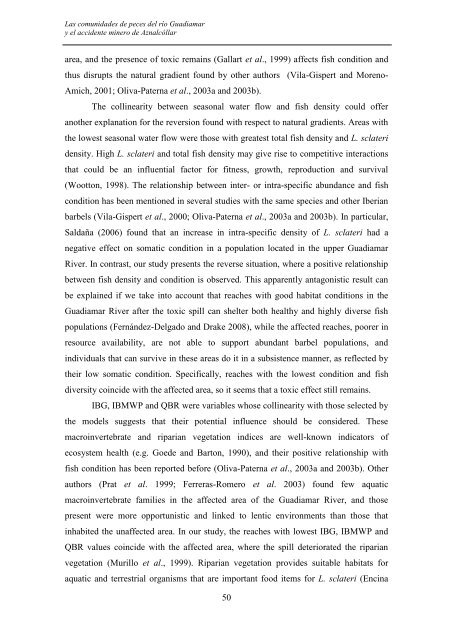las comunidades de peces del río guadiamar y el accidente minero ...
las comunidades de peces del río guadiamar y el accidente minero ...
las comunidades de peces del río guadiamar y el accidente minero ...
You also want an ePaper? Increase the reach of your titles
YUMPU automatically turns print PDFs into web optimized ePapers that Google loves.
Las <strong>comunida<strong>de</strong>s</strong> <strong>de</strong> <strong>peces</strong> <strong>de</strong>l <strong>río</strong> Guadiamar<br />
y <strong>el</strong> acci<strong>de</strong>nte <strong>minero</strong> <strong>de</strong> Aznalcóllar<br />
area, and the presence of toxic remains (Gallart et al., 1999) affects fish condition and<br />
thus disrupts the natural gradient found by other authors (Vila-Gispert and Moreno-<br />
Amich, 2001; Oliva-Paterna et al., 2003a and 2003b).<br />
The collinearity between seasonal water flow and fish <strong>de</strong>nsity could offer<br />
another explanation for the reversion found with respect to natural gradients. Areas with<br />
the lowest seasonal water flow were those with greatest total fish <strong>de</strong>nsity and L. sclateri<br />
<strong>de</strong>nsity. High L. sclateri and total fish <strong>de</strong>nsity may give rise to competitive interactions<br />
that could be an influential factor for fitness, growth, reproduction and survival<br />
(Wootton, 1998). The r<strong>el</strong>ationship between inter- or intra-specific abundance and fish<br />
condition has been mentioned in several studies with the same species and other Iberian<br />
barb<strong>el</strong>s (Vila-Gispert et al., 2000; Oliva-Paterna et al., 2003a and 2003b). In particular,<br />
Saldaña (2006) found that an increase in intra-specific <strong>de</strong>nsity of L. sclateri had a<br />
negative effect on somatic condition in a population located in the upper Guadiamar<br />
River. In contrast, our study presents the reverse situation, where a positive r<strong>el</strong>ationship<br />
between fish <strong>de</strong>nsity and condition is observed. This apparently antagonistic result can<br />
be explained if we take into account that reaches with good habitat conditions in the<br />
Guadiamar River after the toxic spill can sh<strong>el</strong>ter both healthy and highly diverse fish<br />
populations (Fernán<strong>de</strong>z-D<strong>el</strong>gado and Drake 2008), while the affected reaches, poorer in<br />
resource availability, are not able to support abundant barb<strong>el</strong> populations, and<br />
individuals that can survive in these areas do it in a subsistence manner, as reflected by<br />
their low somatic condition. Specifically, reaches with the lowest condition and fish<br />
diversity coinci<strong>de</strong> with the affected area, so it seems that a toxic effect still remains.<br />
IBG, IBMWP and QBR were variables whose collinearity with those s<strong>el</strong>ected by<br />
the mo<strong>de</strong>ls suggests that their potential influence should be consi<strong>de</strong>red. These<br />
macroinvertebrate and riparian vegetation indices are w<strong>el</strong>l-known indicators of<br />
ecosystem health (e.g. Goe<strong>de</strong> and Barton, 1990), and their positive r<strong>el</strong>ationship with<br />
fish condition has been reported before (Oliva-Paterna et al., 2003a and 2003b). Other<br />
authors (Prat et al. 1999; Ferreras-Romero et al. 2003) found few aquatic<br />
macroinvertebrate families in the affected area of the Guadiamar River, and those<br />
present were more opportunistic and linked to lentic environments than those that<br />
inhabited the unaffected area. In our study, the reaches with lowest IBG, IBMWP and<br />
QBR values coinci<strong>de</strong> with the affected area, where the spill <strong>de</strong>teriorated the riparian<br />
vegetation (Murillo et al., 1999). Riparian vegetation provi<strong>de</strong>s suitable habitats for<br />
aquatic and terrestrial organisms that are important food items for L. sclateri (Encina<br />
50

















